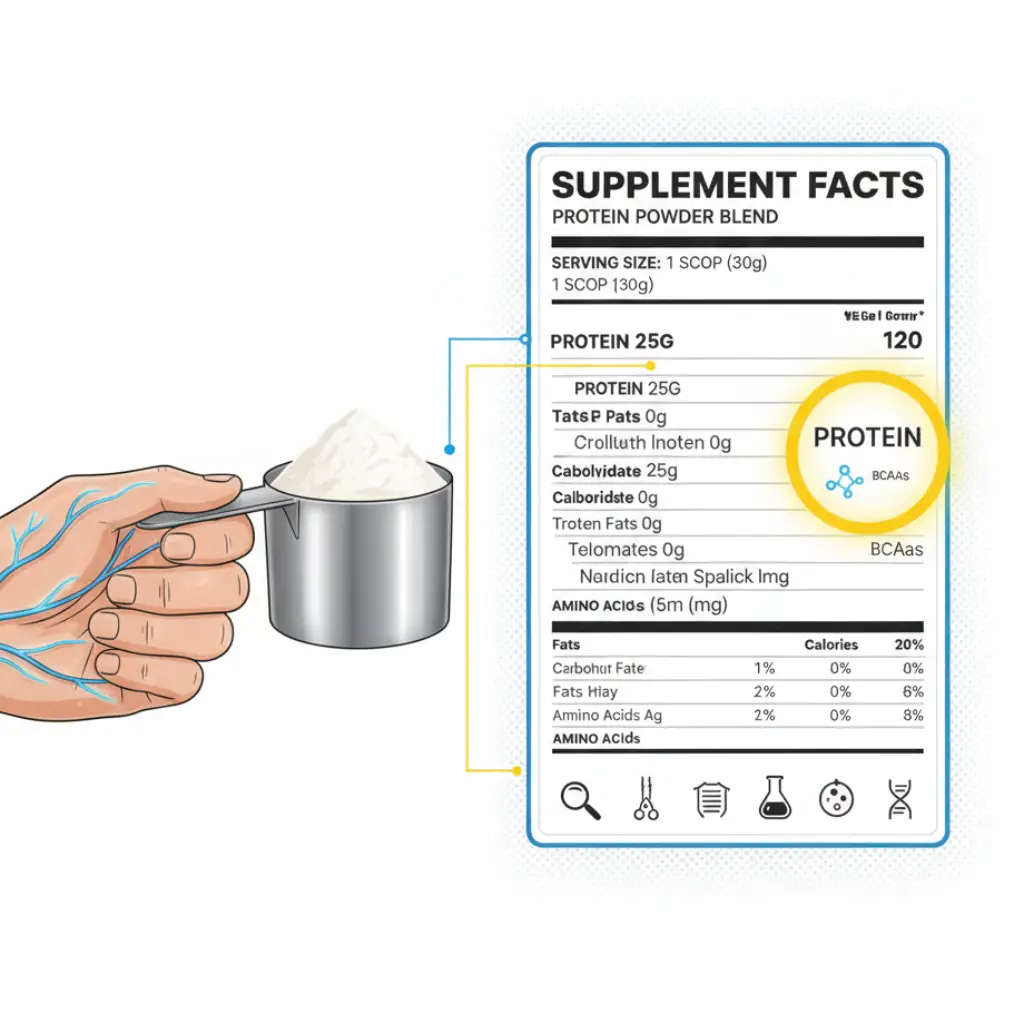If you’ve ever stared at a protein powder tub wondering what all those numbers and claims mean, you’re not alone. Learning how to read protein supplement labels is the difference between buying a high-quality supplement and wasting money on fillers. This guide shows you how to analyze protein supplement ingredients, check protein purity, understand BCAAs in protein, and use a supplement label guide to make confident choices in the gym and the store.

Table of Contents
How to Read Protein Supplement Labels for Beginners
Why Learning How to Read Protein Supplement Labels Matters
Most protein powders look the same on the shelf, but labels tell the real story. A powder with clean ingredients supports recovery, while a poorly formulated one may cause bloating, excess calories, or no results at all. Reading labels protects your health, wallet, and fitness progress.
Key Terms on Protein Supplement Labels You Must Know
- Serving Size: The scoop measurement the nutrition facts are based on.
- Calories: Total energy per serving.
- Protein Per Serving: The most important metric—aim for 20–30 grams.
- Amino Acid Profile: Breakdown of essential amino acids and BCAAs.
- %DV: Daily Value percentages based on a 2,000-calorie diet.
Protein Supplement Ingredients Explained
How to Read Protein Supplement Ingredients on Labels
Protein source is the first thing to check:
- Whey concentrate: Affordable, but higher in carbs and fats.
- Whey isolate: Higher protein purity, easier to digest.
- Casein: Slow-digesting, ideal before bed.
- Plant-based proteins: Pea, rice, soy, or blends for vegans.
👉 Related guide: Whey vs Plant Protein
Fillers and Additives to Spot on Protein Supplement Labels
Common fillers include:
- Artificial sweeteners: Sucralose, acesulfame potassium.
- Thickeners: Xanthan gum, guar gum.
- Flavor enhancers: Natural/artificial flavors.
A clean product should list fewer than 8–10 total ingredients.
Protein Purity and Label Accuracy
How to Read Protein Purity on Supplement Labels
Protein purity = (grams of protein ÷ scoop weight). Example:
- Scoop size: 30g
- Protein: 24g
- Protein purity: 80%
Anything above 70% is solid; below 65% usually means more fillers than protein.
Spotting Low-Quality Protein Powders Through Labels
Watch out for:
- Amino spiking: Adding cheap amino acids like glycine to inflate numbers.
- Proprietary blends: Hides exact amounts.
- Low protein-to-calorie ratio: Too many carbs/fats per serving.

BCAAs in Protein and What Labels Tell You
How to Read BCAAs in Protein Supplement Labels
Whey and high-quality plant blends naturally contain BCAAs. If a brand highlights “extra BCAAs added,” it often signals a weaker protein source being masked.
Do You Need Added BCAAs on Supplement Labels?
For most athletes, no. A quality protein already delivers enough leucine, isoleucine, and valine. Standalone BCAAs only help in fasted training or vegan diets.
Calories and Macros on Protein Supplement Labels
How to Read Calories on Protein Supplement Labels
Calories scale with scoops. If you double-scoop, you double macros too. Many powders also sneak in carbs through maltodextrin or fats through added oils—watch the ingredient list closely.
Using a Nutrition Facts Calculator for Label Accuracy
If numbers look suspicious, use a nutrition facts calculator or nutrition facts label generator. Input the grams of protein, carbs, and fat; the tool should match the company’s calorie claim.
International Labeling Differences
Nutrition Facts vs Nutrition Facts Français on Protein Labels
- U.S. Labels: Calories first, %DV listed.
- Canadian (Français): Macronutrients highlighted differently, bilingual requirement.
Both contain the same core data but appear in slightly different formats.
FDA Labeling Guide for Protein Supplements
The FDA regulates how labels must be presented, but not the quality of the product. Supplements can list “proprietary blends” without showing exact ingredient breakdowns. Always choose transparent brands.
Supplement Label Guide for Different Fitness Goals
How Strength Athletes Should Read Protein Supplement Labels
Powerlifters and bodybuilders should look for:
- Whey isolate: Fast digestion post-workout.
- Higher protein per serving: 25–30g.
- Complete amino acid profile: Natural BCAAs included.
👉 Related: Protein Timing and Recovery
How Weight-Loss Seekers Should Read Protein Supplement Labels
Key things for fat loss:
- Low calorie per scoop (100–120).
- Minimal carbs and fats.
- No added sugar.
👉 Learn more: Protein for Weight Loss vs Muscle Gain
Practical Tips for Reading Protein Supplement Labels
Quick Checklist: How to Read Protein Supplement Labels the Right Way
- Look for 20–30g protein per scoop.
- Aim for 70–80% protein purity.
- Avoid long ingredient lists and amino spiking.
- Check for third-party certifications.
👉 Starter resource: Best Protein Powder for Beginners
Comparing Food Labels vs Protein Supplement Labels
Protein powders are convenient, but don’t replace real food. Whole foods like chicken, beans, and fish often give better overall nutrition.
👉 See comparison: Best High Protein Foods vs Supplements
Conclusion: Key Takeaways
- Learning how to read protein supplement labels saves money and ensures product quality.
- Focus on protein purity (≥70%), natural protein supplement ingredients, and balanced BCAAs in protein.
- Always double-check calories and serving sizes.
- Use tools like a nutrition facts calculator when in doubt.
- Whole foods still beat powders for overall nutrition.
👉 Further reading:
- Protein Myths Debunked
- Protein for Different Diets (Vegan, Keto, etc.)
- Protein Supplements for Women vs Men
FAQs
What is a nutrition facts label generator for protein supplements?
It’s an online tool that creates mock nutrition labels based on macros.
How does a nutrition facts calculator help in reading labels?
It verifies calorie counts by calculating protein, carbs, and fat values.
What is nutrition facts français on protein supplement labels?
It’s the French version of Canada’s Nutrition Facts label, required on all supplements there.
Where to find a nutrition facts label template for protein powders?
The FDA and Health Canada both provide free label templates for manufacturers.
Visit my Instagram account for more.
